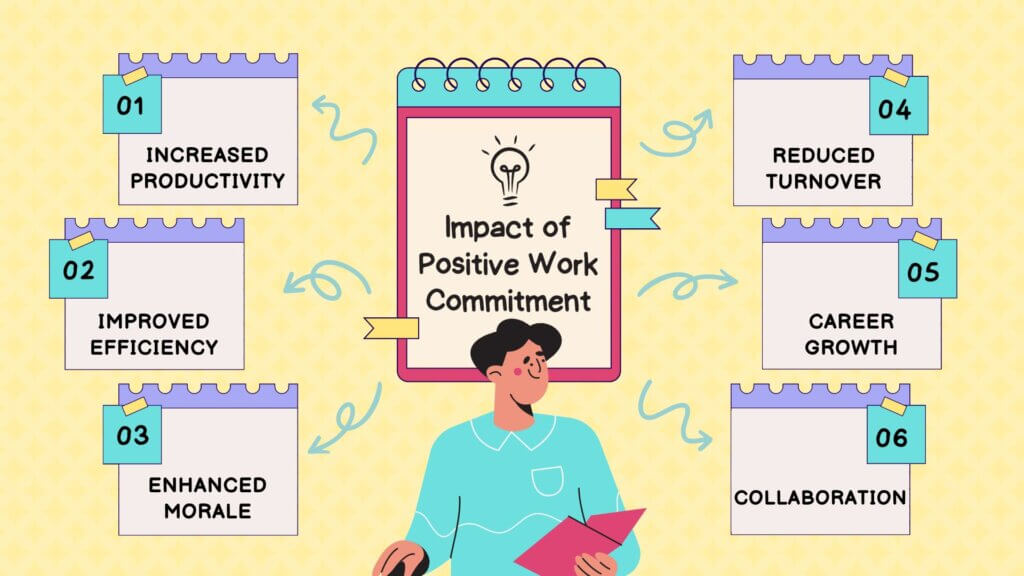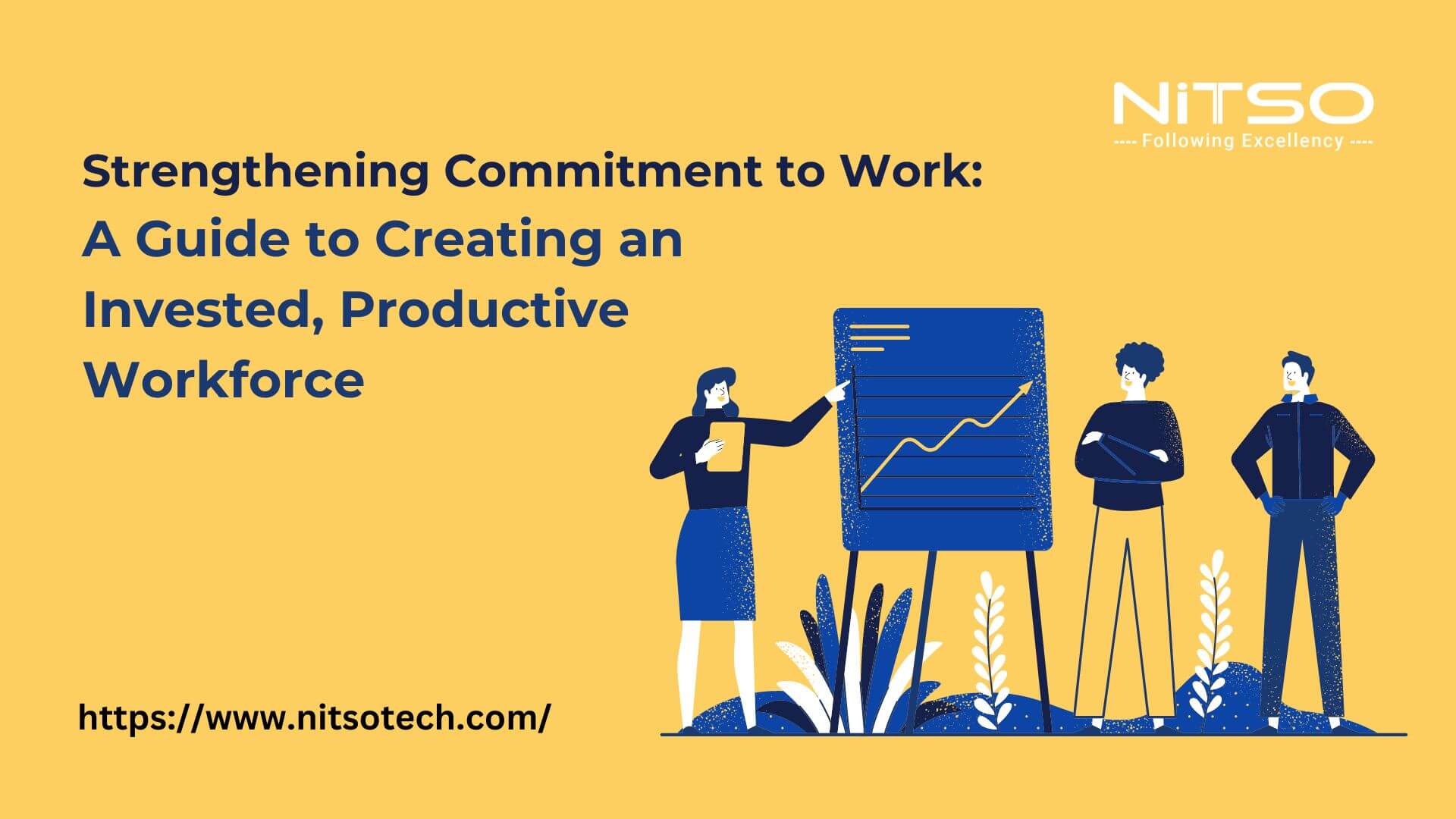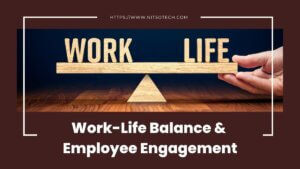In today’s competitive job market, it’s more important than ever for employees to demonstrate a strong commitment to their work. But what exactly is work commitment, and why does it matter so much to employers?
Commitment to work refers to an employee’s dedication to their job, organization, and mission. It goes beyond just showing up and putting in time – it means truly believing in what your company represents and standing behind its goals and values. Employees with high commitment to work feel a sense of connection to their roles and are willing to put in extra time, effort, and sacrifice to see their organization succeed.
Work commitment pays off for both employees and organizations. This article will explore why it’s so important, how to build a culture that fosters it, and what you can do as an employee to strengthen your commitment to work. Let’s dive in!
Table of Contents
What is Work Commitment Meaning for Employees?
Work commitment is characterized by a strong belief in and acceptance of an organization’s goals and values. Employees who demonstrate high commitment to work align their own goals with that of the company and work diligently to fulfil the organization’s mission and vision.
Some common commitment to work examples include:
- Willingness to exert extra time and effort – Committed employees often volunteer for extra projects and assignments, work beyond regular hours, and skip breaks to achieve objectives. They go above and beyond basic expectations.
- Loyalty to the employer – Highly committed workers turn down job offers from competing companies and stick with an organization even during tough times. Their priorities lie with benefiting their employer.
- Focus on continuous improvement – Employees with high work commitment look for ways to constantly develop their skills to improve their output and contribution. They pursue training opportunities that make them more effective in their roles.
While commitment at work manifests differently across roles, these examples illustrate what a highly dedicated worker looks and acts like within an organization. Developing this level of commitment pays rewards for both the employee and the employer.
Helen Keller once wisely stated:
I long to accomplish a great and noble task, but it is my chief duty to accomplish small tasks as if they were great and noble.
This sentiment powerfully captures the essence of work commitment. True dedication is not defined by the prestige or visibility of the work itself, but by the integrity and purpose we bring to whatever we do. Even small roles and everyday tasks matter when done well and with a commitment to excellence.
3 Main Levels of Employee Commitment
1. Compliance Commitment
The lowest level where employees adhere to basic rules and expectations but are not emotionally invested or particularly motivated. They simply want to keep their jobs. Some additional characteristics are:
- Do the minimum required
- Lack emotional attachment
- Focus on extrinsic rewards like pay
- Won’t go beyond the job description
2. Identification Commitment
Employees identify with the organization’s goals and feel a sense of belonging. They exert effort mainly to support the organization. Some additional characteristics are:
- Proud to work at the company
- Make some sacrifices for the organization
- Good team players
- Have some engagement in work
3. Internalization Commitment
The highest level where employees are fully engaged and passionate about their roles. Their values align with the organization’s values. Some additional characteristics are:
- Complete emotional investment
- Internal drive to contribute
- Very involved and enthusiastic
- Will exceed expectations consistently
- Passionate brand ambassadors
Building internalization commitment should be the goal to create an inspired, productive workforce. This requires tapping into employees’ inherent motivations and sense of purpose.

The Impact of Positive Work Commitment
Developing a strong commitment to work among employees comes with many benefits for organizations. Workers who feel invested in their company’s success will go above and beyond to help the organization thrive.
Some of the key positive impacts of high work commitment include:
- Increased productivity – Employees who feel connected to their work and company tend to be more motivated, creative, and productive. They get more done in less time.
- Improved efficiency – Committed workers find ways to streamline processes and reduce waste. Their focus on continuous improvement leads to higher-quality work.
- Enhanced morale – Employees with high commitment feel their work is meaningful. This fulfils their need for purpose and keeps morale high even during tough times.
- Reduced turnover – When employees feel invested in their work, they are less likely to leave the company. Replacing staff is extremely costly for employers.
- Career growth – Committed employees tend to embrace opportunities for advancement. Their focus on self-improvement benefits their careers as well as the organization.
- Collaboration – Work commitment fosters teamwork and information sharing. A collaborative workforce solves problems faster.
The Consequences of Negative Commitment at Work
On the flip side, low commitment to work can significantly impair an organization’s effectiveness and undermine its goals. Employees who feel disconnected or unsatisfied with their jobs tend to underperform and disengage, leading to some notable consequences.
Some of the potential downsides of poor work commitment include:
- Declining productivity – Workers lacking commitment are less motivated and energized by their roles. They use time inefficiently and avoid going above basic expectations.
- Increase in errors – Low commitment leads to complacency. Workers may overlook details, skip protocols, or make foolish mistakes resulting in reduced quality.
- Higher absenteeism – Employees lacking engagement are more likely to miss work, show up late, or take unplanned time off. This disrupts operations.
- Negative attitude – Disengaged workers spread negativity that drags down morale and breeds conflicts. Their apathy is contagious.
- Lack of growth – Uncommitted workers are less likely to seek development opportunities. Their stagnation hinders career mobility.
- Talent loss – Workers who don’t feel invested in the organization are apt to resign. Turnover is hugely expensive.
Fostering a commitment to work is critical for avoiding these mistakes that jeopardize an organization’s performance and health. When commitment lags, it harms productivity, service quality, efficiency, and collaboration.
Competitive Advantage of Work Commitment
With the many benefits of high commitment at work and the risks of low commitment, it’s clear why it’s so important for organizations to cultivate dedicated, engaged employees.
Here are some key reasons why work commitment should be a priority:
- Drives business results – Committed employees go above and beyond to help their company succeed. This directly translates to improved productivity, profitability, and achieving strategic goals.
- Competitive advantage – An engaged, committed workforce is difficult for competitors to replicate. It provides an edge in innovation, customer service, and overall performance.
- Employee retention – Workers who feel invested in the organization are less likely to leave. Replacing employees is extremely costly in terms of recruitment, training, and lost productivity.
- Enhanced reputation – Committed employees become brand ambassadors who build community goodwill. This strengthens public perception.
- Risk reduction – All businesses face uncertainty, and committed workers help stabilize companies during periods of change and adversity.
7 Barriers to Building Employee Commitment at Work
While most employees want to feel engaged and committed to their work, various factors can hinder that mindset. Understanding the barriers to commitment at work enables organizations to proactively address issues.
Some common obstacles that hamper work commitment include:
- Lack of clarity – Unclear expectations, roles, and priorities cause confusion and frustration for workers, diminishing commitment.
- Minimal freedom – Micromanagement and rigid structures prevent employees from feeling empowered and invested in their jobs.
- Limited development – Stagnant workers will disengage if they lack avenues for career growth and skill building.
- Imbalance – Overworked employees struggle to balance personal and professional lives, draining their commitment reserves.
- Weak leadership – Dysfunctional management undermines morale and trust needed to foster commitment.
- Minimal rewards – Employees who feel undervalued or unrecognized for their contributions often withdraw commitment.
- Limited communication – When objectives, expectations, and feedback are unclear, workers feel disconnected from organizational goals.
Actionable Ways to Improve Work Commitment
There are many strategies organizations and individuals can use to overcome obstacles and enhance work commitment. Here are some best practices:
For Organizations:
- Set clear goals and expectations so employees understand priorities.
- Offer development opportunities like training and stretch assignments.
- Give frequent recognition and rewards for achievements.
- Promote open communication and transparency around decisions.
- Foster an ethical, inclusive culture where all employees feel valued.
- Provide opportunities for staff to socialize and build rapport.
- Check-in regularly via surveys to monitor and improve engagement.
For Individuals:
- Align your personal values and strengths with organizational goals.
- Block off time to focus deeply on meaningful projects.
- Set development goals and share aspirations with your manager.
- Build relationships with colleagues by being a team player.
- Practice time management to avoid burnout.
- Communicate needs and seek feedback from leadership.
- Share insights and solutions to drive the organization forward.
By focusing on clarity, communication, development, well-being, and culture, both employers and staff can significantly strengthen their commitment to work. Small consistent efforts blend over time into an engaged, dedicated workforce.
Key Insights
Work commitment is a crucial ingredient for organizational success. Employees who feel invested in their company’s purpose and goals will go above and beyond to help the organization thrive. Their engagement and dedication drive better performance across all metrics. Visit to know about Performance Management Systems (PMS).
However, lack of clarity, minimal rewards, poor leadership, and other barriers can deteriorate work commitment. Organizations must be bold about assessing and enhancing engagement levels through open communication, professional development initiatives, proper recognition and compensation, and fostering an inclusive culture where employees feel their contributions matter.
With the right strategies, any organization can develop an exceptional level of commitment to work among its workforce. As the job market grows more complex, developing engaged, loyal teams will only grow in importance. Prioritizing work commitment now will prepare any organization to successfully navigate the challenges ahead.
FAQs Related to Commitment at Work
Why is work commitment important for employees?
Employees with high work commitment tend to have greater job satisfaction, career advancement opportunities, and recognition from leaders. They feel their work is meaningful which motivates them.
What are some key signs of low work commitment?
Signs of low commitment include frequent absenteeism, lack of engagement, low productivity, and showing little interest in advancement. Employees may do the bare minimum.
How can organizations improve employee work commitment?
Organizations can improve commitment by setting clear goals, offering development opportunities, giving regular feedback and recognition, promoting work-life balance, and fostering positive relationships among staff.
Which is better for an organization – an engaged employee or a happy employee?
Engaged employees tend to be more productive, loyal, and willing to go the extra mile. But employee happiness also matters for retention and attraction. Organizations need both engagement and happiness.
How can you tell if your work commitment is decreasing?
Signs of eroding work commitment include lacking energy at work, frequently complaining about your job, feeling disconnected from the company’s mission, and dreading going to work.
What should you do if you feel your work commitment is declining?
Have an open discussion with your manager on factors causing you to disengage. Look for ways to challenge yourself in your role. Consider transfer opportunities that align with your strengths/interests.







0 Comments